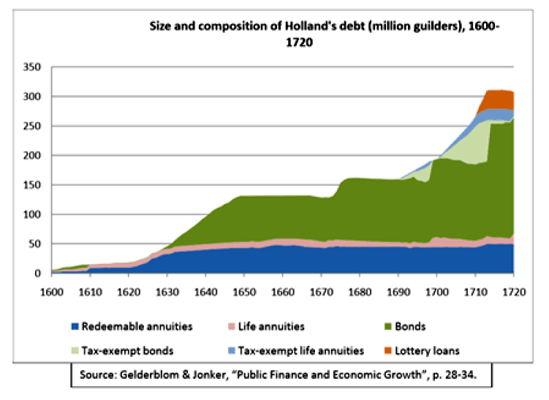Johan de Witt - The first calculation on the valuation of life annuities
Livia Daxenberger
Historical Background
What is nowadays known as the Netherlands used to be under Spanish rule up until the late 16th century ('t Hart, 2014). After the union of Utrecht in 1579, which declared the will to break away from Spanish rule, the Netherlands were founded in 1581 with the "Acte van Verlatinghe" as the "Seven United Provinces" (Kupers, 2014). The Spanish government only acknowledged Dutch independence in 1648 with the end of the 80-year war, which had been an ongoing revolt between the two oppositions, reinforced in the 30-year war involving the whole of Europe. The peace of Westphalia in 1648 hence marked the definite independence of the United Provinces, which were already established as a European player by then. During a time of truce at the beginning of the 17th century, many economic developments had been undertaken and tax reforms carried out, increasing the tax revenue manifold (Fritschy, 2003). The Provinces gained the opportunity to borrow large sums on the capital market (Tracy, 1985), and soon Amsterdam became the trade capital of Europe. Especially the United East Indian Company founded in 1602 contributed to the wealth of the Seven Provinces. During this Golden Age, many of the country's universities were founded, and not only trade, but also Science and Art flourished during this time.
Politically, the peace of Westphalia marked a success in foreign-policy struggles, but domestic issues remained. The "prinsgezinden", a centralist movement supporting the Orangists under reigning Prince Willem II, opposed the republican "staatsgezinden". The sudden death of Willem II in 1650 without a family successor old enough for the throne, power shifted in favour of the Staatsgezinden (Rowen, 1978). Without a Stadtholder, which was a hereditary role, the position of Grand Pensionary - the state servant of Holland, the Provinces' most important county - was extended to make it the most influential position of the United Provinces. The Grand Pensionary had influence over state finances and the executive branch, effectively making him the leader of the Seven Provinces (Hup, 2011).
Financially, the Provinces faced several issues throughout the 17th century. The unfolding of trade and the accompanying expansion of the capital market that took place from early 1600 marked an increase in state debt (Kopf, 1927). Continued European wars, especially an ongoing contention with England during the last half of the century, posed a strain on the state and required solutions to fund a war budget.
Figure 2 shows that the Provinces' debt mainly consisted of redeemable annuities, life annuities, and increasingly bonds. The latter was the only short-term debt instrument. Redeemable annuities - "losrenten" - and life annuities - "lijfrenten" - lasted long-term, with the latter terminating upon death of the assigned person and the former upon redemption of the afore-paid. Both annuities, other than bonds, were subject to a tax when transferred to a new bearer, which made them less liquid and popular than more promptly redeemable bonds (Hup, 2011). These attractive features explain the fast-rising demand for bonds in Figure 2. However, the transfer tax and upfront payment from annuities made annuities more favourable to the government.

Reforms and expansions of the tax system as well as financial trading caused tax revenue to increase thirty-fold from 0.34 million guilders to 10.5 million guilders between 1550 and 1635 (Kupers, 2014). Accounting for population growth and inflation, it was still a five-fold net increase. At the same time, state expenditure increased to 20 million guilders from a previous 3 million guilders between 1587 and the 1630s ('t Hart, 1997). Overall, the Provinces' provincial debt rose from 1.4 million guilders in 1573 to around 140 million guilders in the 1650s, as seen in the figure above (Vries et al., 1997). The substantial growth of financial markets came with new challenges to manage the state budget, and solutions to the debt problem were part of many official meetings (Houtzager, 1950).
The 17th century was a time of big changes and challenges for the United Provinces, which is the scene that Johan de Witt enters into as a defining character during his political career.